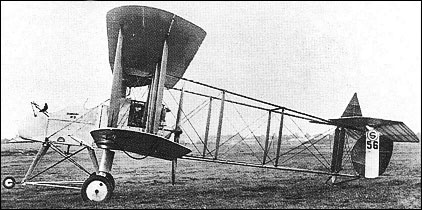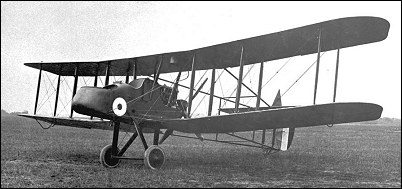|
| Sharing little more than its configuration with the F.E.2
flown at Farnborough in 1913, the F.E.2a appeared early
in 1915 and was designed to provide the RFC with an
armed reconnaissance aircraft. It was a large three-bay
biplane, using a flat centre section and outer panels
that were identical with those of the B.E.2c,
and incorporating dihedral. A short nacelle carried the
observer/gunner in the nose ahead of the pilot, and the
pusher engine. The tail unit was carried by four booms
extending aft from the wings and comprised a large
tailplane with elevators, a kidney-shaped rudder and
small triangular fin above the tailplane. A small nosewheel
was provided ahead of the oleo-strutted main
wheels to help prevent nosing over, and the whole of
the upper wing centre section trailing-edge aft of the
rear spar was hinged for use as a flap-cum-airbrake.
Armament normally comprised a 7.7mm
Lewis machine gun in the front cockpit on one of
several alternative mounts. The first F.E.2a flew on 26
January 1915 with a 100hp Green six-cylinder inline
water-cooled engine but proved underpowered and the 120hp Austro-Daimler built under licence by Beardmore
became the standard for 11 more F.E.2a's and
early production examples of the F.E.2b. The latter was
the "productionised" version with the Beardmore
engine, trailing-edge flap deleted, simplified fuel
system and other changes to facilitate large-scale production
by inexperienced companies. These comprised,
apart from the RAF itself (which built only 47
F.E.2b's): Boulton & Paul (250); Barclay Curie (100);
Garrett & Sons (60); Ransome, Sims & Jefferies (350);
Alex Stephen and Sons (150) and G & J Weir (600). A
160hp Beardmore engine was adopted later, and the
oleo u/c with nose wheel gave way to a simplified form
without the nosewheel or, later, a non-oleo V-strut arrangement. All 12 F.E.2a's and almost a thousand
F.E.2b's went to RFC squadrons in France, where they
engaged in offensive patrols over the enemy lines in
the role of fighter escort for unarmed reconnaissance aircraft. Over 200 were issued to Home Defence units,
some of these flying as single-seaters, and service use
of the F.E.2b continued until the Armistice in November
1918.
| MODEL | F.E.2b with 160hp Beardmore en |
| WEIGHTS |
| Take-off weight | 1378 kg | 3038 lb |
| Empty weight | 935 kg | 2061 lb |
| DIMENSIONS |
| Wingspan | 14.56 m | 48 ft 9 in |
| Length | 9.83 m | 32 ft 3 in |
| Height | 3.84 m | 13 ft 7 in |
| Wing area | 45.89 m2 | 493.96 sq ft |
| PERFORMANCE |
| Max. speed | 147 km/h | 91 mph |
| Ceiling | 3353 m | 11000 ft |
 | A three-view drawing of F.E.2b (1280 x 844) |
| Eric bird, e-mail, 16.10.2023 19:12 Fe2b.Can any one inform me what is the small propeller powered unit under the cockpit.the one on display at RAF museum Hendon has got one.pump?. reply | | Frank Taylor, e-mail, 08.01.2022 11:55 My father joined the RFC as an Observer in 1917 and flew in the Fe2b. He later made a clock from the hub of a four bladed prop' from a Napier Gnome engine. Until I recently discovered that the Fe2b was powered by a Beardmore I had made the wrong connection! Does anyone know which aircraft the Gnome powered? reply | | Anonymous, 23.12.2021 17:13 The "FEE" was a pre-war design and was among the very first aircraft specifically intended to carry a machine gun. It was designed as a pusher because, at that time, no practical method existed to fire a machine gun through the propeller. During the early part of WW-I it was a formidable aircraft and was used both as an air-to-air fighter and as a bomber. When newer aircraft began to eclipse its' performance, it continued to be used as a night bomber. As was the case with most of the Royal Aircraft Factory's creations, although developed by the Royal Aircraft Factory, most were actually constructed by private contractors under license. reply | | John Wilkins, e-mail, 22.05.2016 15:31 How were the engines on these pusher types started? reply | |
| | Flipper, e-mail, 05.06.2013 14:18 I have just seen a FE2b prop this weekend and from the stamps on the hub it came from a Beardmore engined example. it has a date of 21.3.17 on it but it is only a 2 bladed prop. all the photos so far show a 4 bladed prop especially for the later marks. any explanations out there? Flipper reply | | Jean-Claude.masurel, e-mail, 03.12.2012 11:36 I have a prop blade which comes from a RAF FE.2b. The central bearing hub and the four blades are wooden made and the extremity of blades is copper covered.
On the central bearing hub you can read: LP 982 A, 160HP Austro_Daimler, FE.2b, Aldam-Heaton & co Ltd.
The prop blade can be seen in south of France. reply | | Terrence Murphy, e-mail, 28.11.2012 16:03 The F.E.2, in its various forms (35 different aircraft), was one of the longest running aircraft ever produced. From the original F.E.2 in 1912 to the F.E.2h in1918, it proved to be an effective no matter what the role (reconnaissance, bomber, fighter, etc.). It finally ended its long run in China with fighting between Chinese warlords in1927. reply | | Bill Atherton, e-mail, 30.07.2012 21:22 I have a prop blade which I believe could well have come from a Beardmore FE2b .The blade is approx 5 ft long and is attached to what appears to be a central bearing hub ;the other three blades have been removed ( sawn off )
It is of wooden construction and bears a small gold coloured shield inscribed with the words " Denny Dumbarton " . The central hub has been stamped as follows..160.AUSTRO DAIMLER FE2B 982A.L.P. DENNY .341. The story passed on through my wife's family is that it was salvaged from a crash site in Cambridgeshire during W.W.1 reply | | wanshan, 20.06.2011 06:48 Thank you very much for the effort to keep alive the memory of those planes that were wood, cloth and wire.
sincerely, Jose Maria Jorge reply | | awesomest, e-mail, 16.02.2010 20:55 I <3 biplanes reply | | paul howden, e-mail, 01.01.2010 20:53 my grandad was a observer in 1914 based at st omer in france and he was shot down and survived the war i want to know where i can get a model of this plane or where i can get a print so i can build 1 for my dad reply | | José María Jorge, e-mail, 19.07.2009 01:44 Dear Sirs,
For my work I was already desperate because I was missing the plane and entering FE2a your website I found the plane very close to my needs. Thank you very much for the effort to keep alive the memory of those planes that were wood, cloth and wire.
sincerely, Jose Maria Jorge reply | | gavin baird, e-mail, 19.06.2009 00:26 My father, Gavin Gibson Baird, flew this aircraft from the airfield at sans les pernnes France being attached to squadron #148 of the Royal Flying Corp..The I /D of the aircraft was "P" reply |
|
Do you have any comments?
|
| 
COMPANY
PROFILE
All the World's Rotorcraft
|








